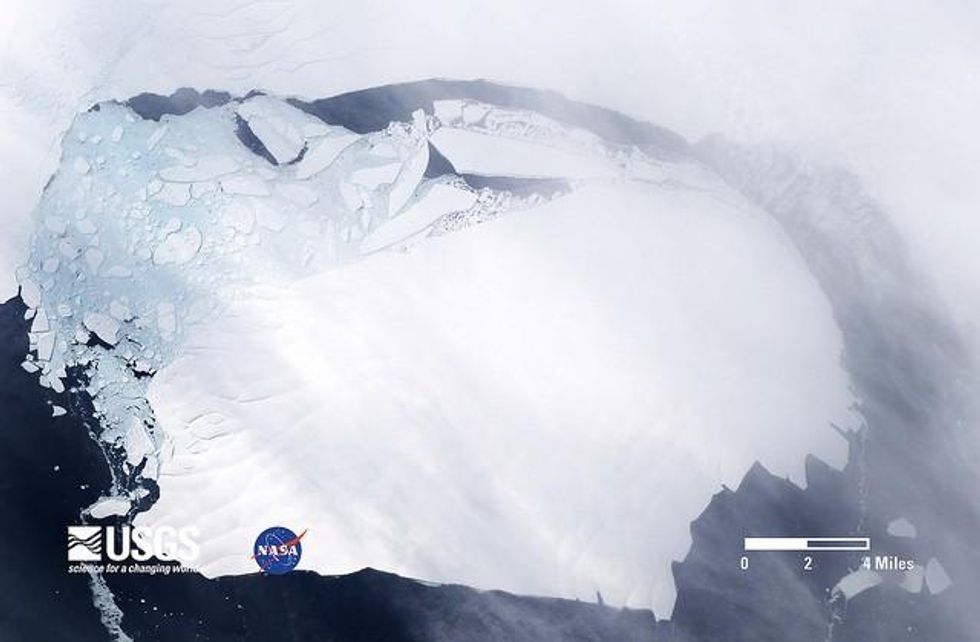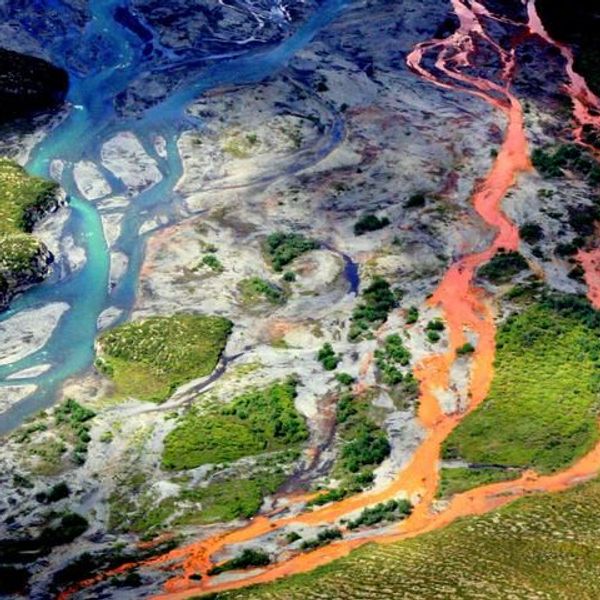Antarctic Glacier's 'Irreversible' Melting Threatens 'Considerable Increase' to Sea Level Rise
New study on Pine Island Glacier shows 'striking vision of the near future,' says co-author

The study published Sunday in the journal Nature Climate Change looked at Pine Island Glacier, the largest single contributor to sea-level rise in the Antarctic.
The team of scientists used three ice flow models to look at the glacier's grounding line, which separates the grounded ice sheet from the floating ice shelf.
The grounding line, which has already retreated by about 10 kilometers in the last decade, "is probably engaged in an unstable 40 kilometer retreat," the study finds.
The glacier "has started a phase of self-sustained retreat and will irreversibly continue its decline," said Gael Durand, a glaciologist with France's Grenoble Alps University and study co-author.
Durand says the findings show "a striking vision of the near future. All the models suggest that [the glacier's] recession will not stop, cannot be reversed and that more ice will be transferred into the ocean."
Agence France-Presse adds:
A massive river of ice, the glacier by itself is responsible for 20 per cent of total ice loss from the West Antarctic Ice Sheet today.
On average, it shed 20 billion tonnes of ice annually from 1992-2011, a loss that is likely to increase up to and above 100 billion tonnes each year, said the study.
"The Pine Island Glacier shows the biggest changes in this area at the moment, but if it is unstable it may have implications for the entire West Antarctic Ice Sheet," Planet Earth Online reports study co-author G. Hilmar Gudmundsson from the National Environment Research Council's British Antarctic Survey as saying.
"Currently we see around two millimeters of sea level rise a year, and the Pine Island Glacier retreat could contribute an additional 3.5 - 5 millimeters in the next twenty years, so it would lead to a considerable increase from this area alone. But the potential is much larger," Gudmundsson warned.
__________________
An Urgent Message From Our Co-Founder
Dear Common Dreams reader, The U.S. is on a fast track to authoritarianism like nothing I've ever seen. Meanwhile, corporate news outlets are utterly capitulating to Trump, twisting their coverage to avoid drawing his ire while lining up to stuff cash in his pockets. That's why I believe that Common Dreams is doing the best and most consequential reporting that we've ever done. Our small but mighty team is a progressive reporting powerhouse, covering the news every day that the corporate media never will. Our mission has always been simple: To inform. To inspire. And to ignite change for the common good. Now here's the key piece that I want all our readers to understand: None of this would be possible without your financial support. That's not just some fundraising cliche. It's the absolute and literal truth. We don't accept corporate advertising and never will. We don't have a paywall because we don't think people should be blocked from critical news based on their ability to pay. Everything we do is funded by the donations of readers like you. Will you donate now to help power the nonprofit, independent reporting of Common Dreams? Thank you for being a vital member of our community. Together, we can keep independent journalism alive when it’s needed most. - Craig Brown, Co-founder |

The study published Sunday in the journal Nature Climate Change looked at Pine Island Glacier, the largest single contributor to sea-level rise in the Antarctic.
The team of scientists used three ice flow models to look at the glacier's grounding line, which separates the grounded ice sheet from the floating ice shelf.
The grounding line, which has already retreated by about 10 kilometers in the last decade, "is probably engaged in an unstable 40 kilometer retreat," the study finds.
The glacier "has started a phase of self-sustained retreat and will irreversibly continue its decline," said Gael Durand, a glaciologist with France's Grenoble Alps University and study co-author.
Durand says the findings show "a striking vision of the near future. All the models suggest that [the glacier's] recession will not stop, cannot be reversed and that more ice will be transferred into the ocean."
Agence France-Presse adds:
A massive river of ice, the glacier by itself is responsible for 20 per cent of total ice loss from the West Antarctic Ice Sheet today.
On average, it shed 20 billion tonnes of ice annually from 1992-2011, a loss that is likely to increase up to and above 100 billion tonnes each year, said the study.
"The Pine Island Glacier shows the biggest changes in this area at the moment, but if it is unstable it may have implications for the entire West Antarctic Ice Sheet," Planet Earth Online reports study co-author G. Hilmar Gudmundsson from the National Environment Research Council's British Antarctic Survey as saying.
"Currently we see around two millimeters of sea level rise a year, and the Pine Island Glacier retreat could contribute an additional 3.5 - 5 millimeters in the next twenty years, so it would lead to a considerable increase from this area alone. But the potential is much larger," Gudmundsson warned.
__________________

The study published Sunday in the journal Nature Climate Change looked at Pine Island Glacier, the largest single contributor to sea-level rise in the Antarctic.
The team of scientists used three ice flow models to look at the glacier's grounding line, which separates the grounded ice sheet from the floating ice shelf.
The grounding line, which has already retreated by about 10 kilometers in the last decade, "is probably engaged in an unstable 40 kilometer retreat," the study finds.
The glacier "has started a phase of self-sustained retreat and will irreversibly continue its decline," said Gael Durand, a glaciologist with France's Grenoble Alps University and study co-author.
Durand says the findings show "a striking vision of the near future. All the models suggest that [the glacier's] recession will not stop, cannot be reversed and that more ice will be transferred into the ocean."
Agence France-Presse adds:
A massive river of ice, the glacier by itself is responsible for 20 per cent of total ice loss from the West Antarctic Ice Sheet today.
On average, it shed 20 billion tonnes of ice annually from 1992-2011, a loss that is likely to increase up to and above 100 billion tonnes each year, said the study.
"The Pine Island Glacier shows the biggest changes in this area at the moment, but if it is unstable it may have implications for the entire West Antarctic Ice Sheet," Planet Earth Online reports study co-author G. Hilmar Gudmundsson from the National Environment Research Council's British Antarctic Survey as saying.
"Currently we see around two millimeters of sea level rise a year, and the Pine Island Glacier retreat could contribute an additional 3.5 - 5 millimeters in the next twenty years, so it would lead to a considerable increase from this area alone. But the potential is much larger," Gudmundsson warned.
__________________

